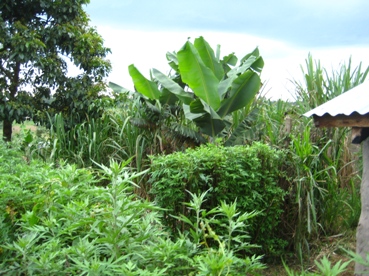57 Value of Traditional Agriculture
Rick Bein
The greatest challenge to understanding how traditional farmers maintain, preserve, and manage biodiversity is to recognize the complexity of their production systems. Today, it is widely accepted that Indigenous knowledge is a powerful resource in its own right and complementary to knowledge available from western scientific sources. Therefore, in studying such systems, it is not possible to separate the study of agricultural biodiversity from the study of the culture that nurtures it. (Altieri, M. A. 1987.)
 Crop mix of dozens of plants and useful weeds. Photo by Rick Bein 2011.
Crop mix of dozens of plants and useful weeds. Photo by Rick Bein 2011.
Many plants within or around traditional cropping systems are wild or weedy relatives of crop plants. In fact, many farmers “sponsor” certain weeds in or around their fields that may have positive effects on soil and crops, or that serve as food, medicines, ceremonial items, teas, soil enrichment or pest repellents. In the Mexican Sierras, the Tarahumara Indians depend on edible weed seedlings or “quelites” (Amaranthus, Chenopodium, Brassica) in the early season from April through July, a critical period before crops mature from August through October. Weeds also serve as alternative food supplies in seasons when maize or other crops are destroyed by frequent hailstorms (Bye, 1981). In barley fields, it is common for Tlaxcala farmers to maintain Solanum mozinianum to levels up to 4,500 plants/hectare, yielding about 1,300 kilograms of fruit, a meaningful input to agricultural subsistence (Altieri and Trujillo, 1987).
As more research is conducted, many of the traditional farming practices once regarded as primitive or misguided, are being recognized as sophisticated and appropriate. Confronted with specific problems of slope, flooding, drought, pests, diseases, low soil fertility, small farmers throughout the world have developed unique management systems aimed at overcoming these constraints (Klee, 1980). In general, traditional agriculturalists have met the environmental requirements of their food-producing systems by concentrating on a few principal characteristics and processes resulting in a myriad of agricultural systems that store the following structural and functional commonalities (Gliessman, 1998; Altieri and Anderson, 1986).
In contrast with commercial agriculture, traditional agriculture can rarely contribute to monetary wealth but can successfully provide a healthy subsistence for farmers. However unadulterated plants from traditional agriculture can be gleaned to strengthen the genetics of commercial crops.

